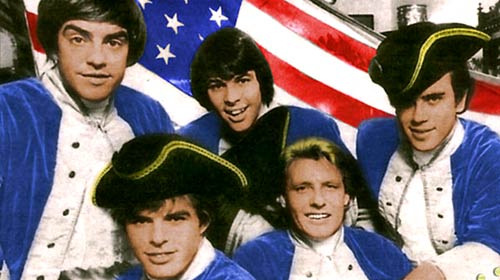Videos by American Songwriter
On March 23, the groundbreaking rock and roll of Paul Revere & The Raiders will be anthologized on Collectors’ Choice Music’s exhaustive compilation, Paul Revere & the Raiders Featuring Mark Lindsay: The Complete Original Columbia Singles. The set will encompass each of the Idaho band’s 62 A and B sides, a format the label has previously used for classic but overlooked ’60s acts like Jan & Dean, Gary Lewis & the Playboys, and Jay & the Americans. The Raiders were unique in the garage rock genre in that they largely wrote their own hits.
The Complete Original Columbia Singles compiles many songs that have previously never appeared on CD, and beloved tracks like “Steppin’ Out,” “Kicks,” “Hungry,” “Just Like Me,” “Good Thing,” “Him Or Me — What’s It Going to Be?,” “Ups And Downs,” “Let Me,” “I Had a Dream,” “Too Much Talk,” and “Indian Reservation.” There are also two bonus cuts: the band’s commercial for the Pontiac Judge GTO Breakaway street rod, and a song they recorded that was packaged with Mattel’s “Swingy Doll.”
This press release, from the ever-entertaining and illuminating pen of Cary Baker, tells their story:
One might not think of Idaho as a hotbed of ’50s rhythm & blues, but that’s where the young Paul Revere (his real name) and Mark Lindsay listened to 50,000-watt Southern radio stations and obscure singles, idolizing artists like Fats Domino and Ernie K-Doe. Like every hip teen in the NW, they loved Richard Berry’s “Louie Louie” and, in April 1963, they and the Raiders recorded and released it on the tiny Sande label. Coincidentally, fellow Northwesterners the Kingsmen had done the same for Wand Records. Ultimately, the Kingsmen won the “Louie Louie” battle, but the Raiders won the record biz war, kicking off a decade-long career as pop hitmakers.
Paul Revere & the Raiders were immediately contacted by a Columbia Records A&R man who — defying the wishes of label A&R head Mitch Miller to focus on easy-listening music — signed them. Terry Melcher, Columbia’s youngest staff producer based in Los Angeles, took a special interest in the band and became, in essence, the group’s George Martin.
Unlike many bands of the era, the Raiders played on their own records. Their 1965 breakout single, “Steppin’ Out,” featured the powerful playing of what is now considered the classic Raiders rhythm line-up: drummer Mike “Smitty” Smith, lead guitarist Drake Levin, and bassist Phil “Fang” Volk.
“Steppin’ Out” hit #46 on Billboard on the strength of the strong radio airplay and an ongoing stint on ABC’s afterschool TV series Where the Action Is. The show’s producer, Dick Clark, promptly put them on the road where they were able to expand their fan base beyond the West Coast. Recognizing their star power, Chevrolet hired them to record theme songs for two of its youth-targeted cars, “SS396” and “Corvair Baby.”
On their next hit, “Just Like Me,” singer Lindsay adopted the breathy vocals that would become his trademark. The single hit the #11 spot on January 11, 1966. Its follow-up, “Kicks,” written by Brill Building denizens Barry Mann and Cynthia Weil, cracked the Top 5. Mann and Weil had written the verses, but the signature guitar riff, later to be emulated by garage bands from coast to coast, came from Drake Levin with expert production by Melcher. Another Mann & Weil tune, “Hungry,” gave the gang their second straight Top 10 hit.
In the spring of 1966, Levin was drafted into the National Guard, and fellow Northwest native Jim “Harpo” Valley from Don & the Goodtimes stepped in to replace him. With much of the nation shut down by the airline strike of 1966, Lindsay quickly penned “The Great Airplane Strike,” which became a follow-up single, backed with a Volk vocal on “In My Community,” which featured Melcher’s friend Van Dyke Parks on organ.
The hit streak continued (“Good Thing,” “Ups and Downs,” Him or Me — What’s it Going to Be?”) and, with the band constantly on tour, Melcher began to hire studio musicians to take up some studio slack. Jack Nitzsche scored the horn section for “Ups and Downs,” and long-time “unofficial Raider” Keith Allison — later to become a bona fide member — played guitar along with Ry Cooder. Also, Wrecking Crew drum legend Hal Blaine began to displace drummer Smitty. The change in musical direction caused disheartened Fang, Smitty and Harpo to resign after a 1967 Ed Sullivan Show appearance. They were replaced by bassist Charlie Coe, drummer Joe Correro Jr., and guitarist Freddy Weller, Southerners all. A new musical influence began to permeate the Pacific Northwest band.
As ’60s pop music lyrics began to respond to current events, the Raiders followed suit with songs such as “I Had a Dream,” “Peace of Mind,” and “Too Much Talk.” Melcher left the fold around this time, Lindsay took on production duties, and the hits kept on comin’: “Don’t Take it So Hard,” Cinderella Sunshine,” and “Mr. Sun, Mr. Moon.” In 1969, Lindsay and Freddy Weller launched solo careers in addition to their duties as Raiders. Rock was changing, but the band had one more charting hit in them, “Indian Reservation,” a song which had been previously recorded by Marvin Rainwater, John D. Loudermilk, Ray Acuff Jr., and the Nashville Teens. Artie Butler played organ and Hal Blaine drums on the Raiders version. After a slow start at radio, the record went all the way to #1, the band’s biggest hit ever.
In 1975, Revere, Lindsay and Allison played the last Paul Revere & the Raiders gig at Knott’s Berry Farm. “Looking back,” says Revere, “we really had an incredible run . . . Any mistakes that were made along the way don’t mean shit after all is said and done. Everything turned out for the best.”








Leave a Reply
Only members can comment. Become a member. Already a member? Log in.